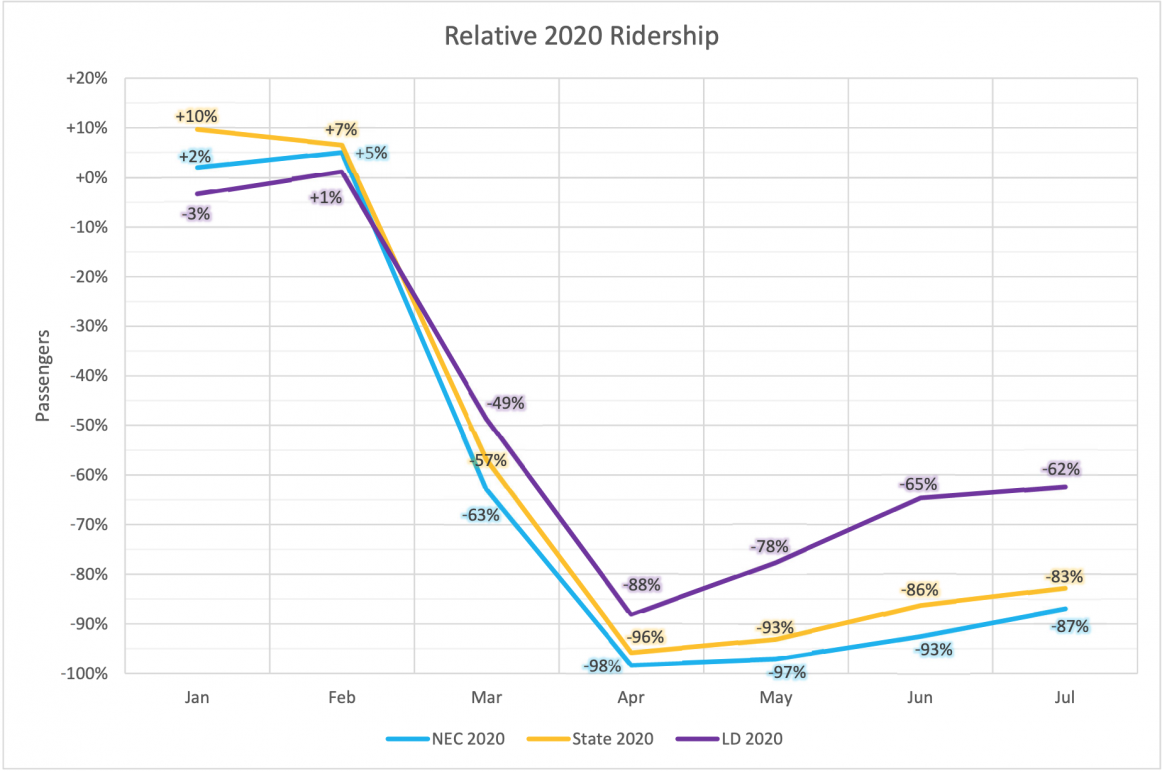Happening Now
Since March, Long-Distance Is Amtrak’s Revenue King
August 28, 2020
Long-distance trains have contributed the largest single share of Amtrak’s revenues in every month this year since the pandemic began.
by Jim Mathews / President & CEO
One thing that the coronavirus pandemic has revealed is just how essential America’s long-distance intercity passenger routes really are: powered by essential journeys, the so-called “money-losing long-distance routes” have contributed the largest single share of Amtrak’s revenues in every month this year since the pandemic began in March.
Throughout the pandemic the intercity routes have demonstrated the degree to which they remain "essential" transportation. Ridership has been holding up more strongly on these routes than in the rest of the system, underscoring how vital these trains are for “Flyover Country” where the options are fewer and less appealing. A look at Amtrak’s revenues and ridership since the pandemic first clobbered the U.S. transportation system tells an interesting tale.
So far, we have financial information through the end of July. During the pandemic period since March, the National Network’s routes have contributed 45% of Amtrak's revenues, compared with 21% a year ago during those same five months.
Since March, NEC revenues are down 90% compared with a 64% decline for the National Network. As for ridership, it plummeted in the NEC and hasn't really recovered. In all of calendar 2020, NEC ridership is down 66%, and during the pandemic period ridership is down 88%. By contrast, the National Network's ridership is only down 53% in 2020, and 68% during the pandemic period.
For calendar 2020 through the close of July, Amtrak's overall revenues are down 62%, a figure that would be much worse except that all three business lines showed strong gains in January and February which helped to cushion the pandemic’s blow. Since the pandemic began, Amtrak’s revenues are down 83% compared with the like period of 2019. Between March and July of 2019, Amtrak had pulled in about a billion dollars in ticket revenues; this year, between March and July total revenues came in at only $177 million.
Amtrak notes that there have been frequency reductions on state-supported and NEC routes that so far have not been duplicated on the long-distance routes, telegraphing that we can expect intercity routes’ performance to slump along with the rest of the system after the three-times weekly service model rolls out on October 1. It’s hard not to wonder whether that’s the point? A new twist on “flattening the curve”...
 (Graphic courtesy Mike Christensen)
(Graphic courtesy Mike Christensen)
It’s been 17 years since then-Senator Kay Bailey Hutchison (R-Texas) introduced her sweeping Amtrak funding bill called the American Rail Equity Act, declaring “our motto for passenger rail is ‘National or Nothing!’” In 2003, Hutchsion and fellow Republicans like Mississippi’s Sen. Trent Lott and Montana’s Sen. Conrad Burns recognized how essential a fully functioning nationwide network of intercity passenger rail routes can be to the country’s prosperity. Today’s Congress broadly agrees and understands the numbers we’ve shared about ridership and revenues on these routes.
Montana Republican Sen. Steve Daines has been leading bipartisan opposition to the three-times weekly plan, issuing a bipartisan letter to Amtrak challenging the plan along with Senators Udall (D-NM), Heinrich (D-NM), Bennet (D-CO), Cramer (R-ND), Braun (R-IN), and Hoeven (R-ND).
Democratic Rep. Dan Lipinski (Ill.), Chair of the House Transportation & Infrastructure Subcommittee on Railroads—and recipient of this year’s Rail Passengers Association Golden Spike – issued a similar condemnation. In fact, the House of Representatives has passed two bills, HR 2 and an FY2020 transportation budget, that would provide plenty of funding to maintain Amtrak service at existing levels while simultaneously banning the railroad from reducing frequencies.
Additionally, committees in both the House and the Senate are contemplating holding hearings in September to examine how the U.S. passenger rail service is weathering the coronavirus pandemic. However, the Senate has yet to act on either HR2 or the FY2020 transportation budget, and these are truly critical pieces of legislation to saving service. Each day that passes while the Senate doesn’t act increases the likelihood of 3x service becoming a reality.
While the legislators are on recess for a couple more weeks, it’s still critical that you take part in our campaign to pressure the Senate to act. Please call your Senators using the capitol switchboard—(202) 224-3121—and tell them you want to see Amtrak daily service protected. Or you can use our online platform to quickly and easily send an email to your Senators. And one call or email is not enough. You need to do this regularly and repeatedly.
Let's flatten a different curve!
"It is an honor to be recognized by the Rail Passengers Association for my efforts to strengthen and expand America’s passenger rail. Golden spikes were once used by railroads to mark the completion of important rail projects, so I am truly grateful to receive the Golden Spike Award as a way to mark the end of a career that I’ve spent fighting to invest in our country’s rail system. As Chair of the Transportation and Infrastructure Committee, it has been my priority to bolster funding for Amtrak, increase and expand routes, look to the future by supporting high-speed projects, and improve safety, culminating in $66 billion in new funding in the Bipartisan infrastructure Law."
Representative Peter DeFazio (OR-04)
March 30, 2022, on receiving the Association's Golden Spike Award for his years of dedication and commitment to passenger rail.
Comments